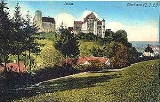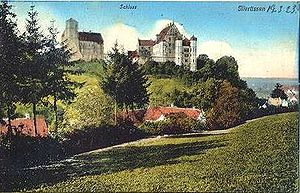
Illertissen
Encyclopedia
Illertissen is a town in the district of Neu-Ulm
in Bavaria
. It is situated approximately 20 km south from Ulm
nearby the river Iller
.
 The oldest evidence of settlement in Illertissen goes back to the beginning of the 6th century A.D. The first documented mention, going by the name "Tussa", was in the year 954. This was on the occasion of the reconciliation by Ulrich, Bishop of Augsburg and the then bishop of Chur
The oldest evidence of settlement in Illertissen goes back to the beginning of the 6th century A.D. The first documented mention, going by the name "Tussa", was in the year 954. This was on the occasion of the reconciliation by Ulrich, Bishop of Augsburg and the then bishop of Chur
, King Otto I.
, and his son Duke Liudolf of Swabia
. The occasion was a military alliance at Lechfeld, with the goal of preventing further penetrations by the Magyars. The three "P"s in the coat of arms may have originated from this event.
From the 12th century to the 13th century the castle of Tissen was developed by the Counts of Kirchberg. Today, the castle is known as the Vöhlin château. Already in 1430 the rule of Kirchberg became the seat of jurisdiction through Emperor Sigismund
for the village of Tissen. From this time on, trade and handcraft blossomed in the region. Beside the farmers and the craftsmen in Illertissen also brewers and webbers were resident. The trade house of the Vöhlin (1520-1757), a patrician family from Memmingen
mostly determined the history of Illertissen. In the 18th century the time of the Vöhlin ended with their financial bankruptcy and the sale of the rule (1756) to the Bavarian elector Maximilian III.
. Since 1803 the château is in possession of the Bavarian state. There were accommodated the offices for pension, district, federal state parliament and finances and also the district court. Since 1983 the Bee- and homeland museum is accommodated in the free rooms.
An important development thrust for the agrarian spahed market was brought by building the train line Ulm - Oberstdorf
in 1861/62, the so called Illertalbahn. West of the train line industry companies settled, the number of inhabitants rose from 1,000 in the year 1800 to 2,500 in the year 1930. From the 1923 inflation the market municipality recovered in 1926. Then came the Nazi regime and the World War II
, a time of fall. Three years after the war the currency reorganization and the free-market economy led in an upswing like never before. New production branches settled. Thus Illertissen could switch itself into the industrializing without destroying the natural living room, the social equilibrium or the skyline. In addition also the refugees of homeland made a remarkable contribution. Straight the 1971 integrated quarter Betlinshausen as well as 1978 in the framework of the local regional reorganization been added quarters Au, Jedesheim and Tiefenbach round the picture off to a grown whole one. Therefore Illertissen was made to a town with around 16,000 inhabitants.
In the case of the district reorganization the former district capital Illertissen had to deliver some offices to the district of Neu-Ulm, but Illertissen did not lose its economical meaning as a regional middle center in the south district.
, France
Loket
, Czech republic
Neu-Ulm (district)
Neu-Ulm is a district in Bavaria, Germany. It is bounded by the districts of Günzburg and Unterallgäu and the state of Baden-Württemberg ....
in Bavaria
Bavaria
Bavaria, formally the Free State of Bavaria is a state of Germany, located in the southeast of Germany. With an area of , it is the largest state by area, forming almost 20% of the total land area of Germany...
. It is situated approximately 20 km south from Ulm
Ulm
Ulm is a city in the federal German state of Baden-Württemberg, situated on the River Danube. The city, whose population is estimated at 120,000 , forms an urban district of its own and is the administrative seat of the Alb-Donau district. Ulm, founded around 850, is rich in history and...
nearby the river Iller
Iller
The Iller is a river in Bavaria, Germany. It is a right tributary of the Danube, 147 km in length.The source is located near Oberstdorf in the Allgäu region of the Alps, close to the Austrian border. From there it runs northwards, passing the towns of Sonthofen, Immenstadt, and Kempten...
.
Coat of arms
The coat of arms lent by Erhard Vöhlin in the year 1530 shows an upright standing lion in red, covered by a black bar with three "P"s in silver capital letters. They stand for Pugnamus pro pace (from the Latin), meaning For peace we fight (not "Pugnamus pro Papa" which means "For the Pope we fight" as has been erroneously suggested.)History

Bishop of Chur
The Bishop of Chur is the Ordinary of the Roman Catholic Diocese of Chur, Grisons, Switzerland .-History:...
, King Otto I.
Otto I, Holy Roman Emperor
Otto I the Great , son of Henry I the Fowler and Matilda of Ringelheim, was Duke of Saxony, King of Germany, King of Italy, and "the first of the Germans to be called the emperor of Italy" according to Arnulf of Milan...
, and his son Duke Liudolf of Swabia
Liudolf, Duke of Swabia
Liudolf was the duke of Swabia from 950 until 954. He was the only son of Otto I, king of Germany, from his wife Eadgyth, daughter of Edward the Elder, king of England....
. The occasion was a military alliance at Lechfeld, with the goal of preventing further penetrations by the Magyars. The three "P"s in the coat of arms may have originated from this event.
From the 12th century to the 13th century the castle of Tissen was developed by the Counts of Kirchberg. Today, the castle is known as the Vöhlin château. Already in 1430 the rule of Kirchberg became the seat of jurisdiction through Emperor Sigismund
Sigismund, Holy Roman Emperor
Sigismund of Luxemburg KG was King of Hungary, of Croatia from 1387 to 1437, of Bohemia from 1419, and Holy Roman Emperor for four years from 1433 until 1437, the last Emperor of the House of Luxemburg. He was also King of Italy from 1431, and of Germany from 1411...
for the village of Tissen. From this time on, trade and handcraft blossomed in the region. Beside the farmers and the craftsmen in Illertissen also brewers and webbers were resident. The trade house of the Vöhlin (1520-1757), a patrician family from Memmingen
Memmingen
Memmingen is a town in the Bavarian administrative region of Swabia in Germany. It is the central economic, educational and administrative centre in the Danube-Iller region. To the west the town is flanked by the Iller, the river that marks the Baden-Württemberg border...
mostly determined the history of Illertissen. In the 18th century the time of the Vöhlin ended with their financial bankruptcy and the sale of the rule (1756) to the Bavarian elector Maximilian III.
Maximilian III, Elector of Bavaria
Maximilian III Joseph was Prince-elector of the Holy Roman Empire and Duke of Bavaria from 1745 to 1777.-Biography:...
. Since 1803 the château is in possession of the Bavarian state. There were accommodated the offices for pension, district, federal state parliament and finances and also the district court. Since 1983 the Bee- and homeland museum is accommodated in the free rooms.
An important development thrust for the agrarian spahed market was brought by building the train line Ulm - Oberstdorf
Oberstdorf
Oberstdorf is a municipality and skiing and hiking town in southwest Germany, located in the Allgäu region of the Bavarian Alps.At the center of Oberstdorf is a church whose tall spire serves as a landmark for navigating around town. The summits of the Nebelhorn and Fellhorn provide...
in 1861/62, the so called Illertalbahn. West of the train line industry companies settled, the number of inhabitants rose from 1,000 in the year 1800 to 2,500 in the year 1930. From the 1923 inflation the market municipality recovered in 1926. Then came the Nazi regime and the World War II
World War II
World War II, or the Second World War , was a global conflict lasting from 1939 to 1945, involving most of the world's nations—including all of the great powers—eventually forming two opposing military alliances: the Allies and the Axis...
, a time of fall. Three years after the war the currency reorganization and the free-market economy led in an upswing like never before. New production branches settled. Thus Illertissen could switch itself into the industrializing without destroying the natural living room, the social equilibrium or the skyline. In addition also the refugees of homeland made a remarkable contribution. Straight the 1971 integrated quarter Betlinshausen as well as 1978 in the framework of the local regional reorganization been added quarters Au, Jedesheim and Tiefenbach round the picture off to a grown whole one. Therefore Illertissen was made to a town with around 16,000 inhabitants.
In the case of the district reorganization the former district capital Illertissen had to deliver some offices to the district of Neu-Ulm, but Illertissen did not lose its economical meaning as a regional middle center in the south district.
Main sights
- Vöhlin Castle, developed in the 12th and 13th century as the "Castle of Tissen" of the Counts of Kirchberg. In 1525-1756 it was a possession of the patrician family Vöhlin from Memmingen. It houses a RococoRococoRococo , also referred to as "Late Baroque", is an 18th-century style which developed as Baroque artists gave up their symmetry and became increasingly ornate, florid, and playful...
chapel and a beeBeekeepingBeekeeping is the maintenance of honey bee colonies, commonly in hives, by humans. A beekeeper keeps bees in order to collect honey and other products of the hive , to pollinate crops, or to produce bees for sale to other beekeepers...
museum. - Parish church St. Martin (1590), with high altar of the high renaissance, built by Christoph Rodt in 1604.
- Historical threshing floor (1847).
- City hall (1891).
Twin cities
CarnacCarnac
Carnac is a commune beside the Gulf of Morbihan on the south coast of Brittany in the Morbihan department in north-western France.Its inhabitants are called Carnacois...
, France
France
The French Republic , The French Republic , The French Republic , (commonly known as France , is a unitary semi-presidential republic in Western Europe with several overseas territories and islands located on other continents and in the Indian, Pacific, and Atlantic oceans. Metropolitan France...
Loket
Loket
Loket is a town of some 3 000 inhabitants in the Sokolov District in the Karlovy Vary region of the Czech Republic.Loket means "elbow" in English. The town is named this due to the town centre being surrounded on three sides by the Ohře River, and the shape the river takes is similar to that of an...
, Czech republic
Czech Republic
The Czech Republic is a landlocked country in Central Europe. The country is bordered by Poland to the northeast, Slovakia to the east, Austria to the south, and Germany to the west and northwest....

